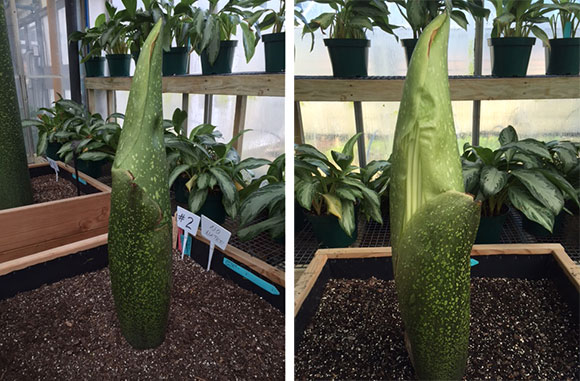Sprout was our third titan arum to bloom.
Sprout Was Huge.
Everything about the titan arum (Amorphophallus titanum) was big: its flower spike, its leaf, its corm. Learn about the titan growth cycle and follow Sprout’s height and girth gain day-to-day on our corpse flower growth chart.

Sprout the titan arum photographed April 11 and 12, 2016
A Blooming Titan Arum Smells Rotten
Bloom night is the big night for the titan arum’s famous stench. The flowering structure generally opens late in the afternoon, and the scent is released that night. It lingers for several hours—when Alice the Amorphophallus bloomed in September 2015, the scent lasted from about 10 p.m. to about 6 a.m.
Said to smell like decaying flesh—from whence its common name derives—the corpse flower releases a blast of scent upon opening, a powerful message sent to the carrion beetles and flesh flies that are the titan arum’s natural pollinators: “I’m over here, I smell like rotting meat, and you should come now.” The smell attracts the insects…that become unwitting carriers of pollen…that is moved from one titan to another…so that fertilization can happen and the plant can reproduce.
Read more about the fascinating titan reproduction process.
Sprout Is Rare
If you followed the adventures of Spike in August 2015 and thrilled to the spectacular bloom of Alice the Amorphophallus in September 2015, you may wonder, “What’s so rare about titan No. 3?”
Yet a corpse flower in bloom is a rare phenomenon, both in the wild and in the horticultural world.
In the titan arum’s natural habitat, the rainforest hillsides of Sumatra, plants are dwindling in number due to deforestation and land clearing for palm oil plantations. It is estimated that 72 percent of its natural habitat has been destroyed.
In botanic gardens and arboreta around the world, titan arums have only recently been coaxed into bloom in any numbers after 10 to 12 years—that’s no small commitment to time and tending.
The Chicago Botanic Garden began its now 13-strong titan arum collection in 2003, by acquiring small corms from a variety of scientific and academic sources. Since it usually takes titan arums a decade-plus to reach bloom size, most of our plants have matured at the same time—fingers crossed for many blooms in our future! In addition, mature corms are now developing offshoots that can be planted separately and allowed to grow at our nursery.
Sprout was germinated from a seed that was sent to us from the University of California Botanical Garden at Berkeley in 2008. Both of Sprout’s parent plants produced pollen there; one in 2005, one in 2007.

